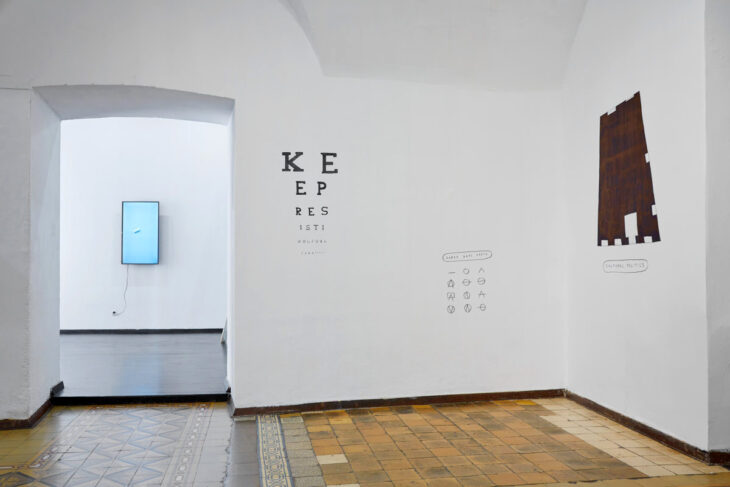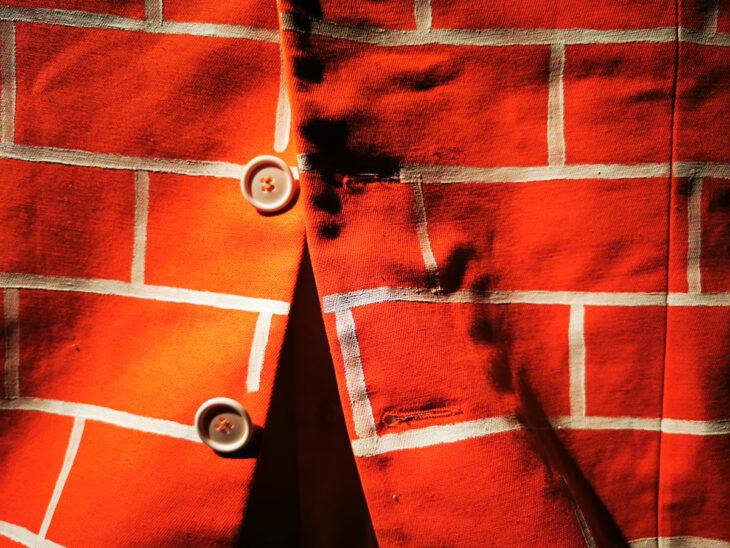
The next 21 days will be crucial
The annual exhibition of the School for Curatorial Practices and Critical Writing World of Art
13 May – 2 June 2021, Škuc Gallery
Artists: Beli sladoled, Nataša Berk, Aldo Giannotti, Adrijan Praznik, Simona Semenič & Nada Žgank, Small but dangers
Curatorial team: Vesna Bukovec, Miha Kelemina, Lara Plavčak
Participants of the 18th generation of the School for Curatorial Practices and Critical Writing World of Art taking part in the preparation and implementation of the exhibition: Katarina Bogataj, Ajda Bračič, Blaž Brumen, Janja Buzečan, Hana Čeferin, Matevž Jerman, Maša Knapič, Teja Kosi, Katarina Lipovac, Teja Miholič, Tamara Mlakar, Ana Obid, Sanja Vatić, Eva Žibert, Maša P. Žmitek
Škuc Gallery, Stari trg 21, Ljubljana
Opening hours:
Tuesday – Sunday: 12 pm – 7 pm
Exhibition Brochure (pdf)
ACCOMPANYING EVENTS
Due to the prevention of the spread of the coronavirus, the exhibition will not have a classic opening. The artists will be present in the gallery on the first day of the exhibition, Thursday, 13 May. The exhibition can be viewed in small groups, masks are obligatory. You are kindly invited!
Wednesday, 19 May at 6 pm: Viewing of the exhibition with curators: Miha Kelemina and Vesna Bukovec and with some of the artists
Wednesday, 2 June at 6 pm: Viewing of the exhibition with curators: Miha Kelemina, Lara Plavčak and Vesna Bukovec and with some of the artists
The exhibition was accompanied by online conversations with artists (Adrijan Praznik, 11 March, Small but dangers, 18 March, Aldo Giannotti, 31 March, Beli sladoled, 8 April, Simona Semenič and Nada Žgank, 8 . 4., Natasa Berk, 22. 4.).
Due to the prevention of the spread of the coronavirus, the exhibition will not have a classic opening. The artists will be present in the gallery on the first day of the exhibition, Thursday, 13 May. The exhibition can be viewed in small groups, masks are obligatory. You are kindly invited!
ABOUT THE EXHIBITION
You may, or may not, see the exhibition The next 21 days will be crucial. We are not trying to be mysterious or (too) funny by saying this. At the time of writing the curatorial text, we are simply not certain that it will be possible to open the exhibition to the public. Since the beginning of the epidemic we have been listening to the predictions of restrictive measures and how the next few days will be crucial for the re-opening of society, and so the phrase in the title of the exhibition is already anchored in local Corona humour. But even after a year, our new reality is still changing from day to day, and at the same time, it seems no less strange and uncertain than it did at the beginning. We are forced to respond to it, as its consequences extend to both personal and socio-political life. Precisely the consideration of the current circumstances, which are often so absurd that we can only react to them with humour, was our curatorial starting point.
Humour is considered a cultural universality that co-determines common and individual cultural identity. As a social phenomenon, it helps build and strengthen bonds, but it can also be the cause of communication breakdowns. One of the theories of humour, the theory of incongruity, states that humorous perception occurs in a discrepancy between the expected and the actual. The humorous appears when the apposed inconsistencies are clarified contrary to expectation, or even dissolve into nothingness. Here, we do not find enjoyment in juxtaposing inconsistencies, but in the resolution of the tension itself, the sudden surprising insight that brings cognitive or aesthetic satisfaction. We are amused by the strangeness of the situation, which, through the comfort of humorous experience, provides our perspective with greater abstractness and manageability.
Such a moment of incongruity and tension, which is resolved into something unexpected, can also be perceived in the artworks of the exhibition. Through them, the artists discuss the laws of the art system and the position of art within the broader field of culture, while also addressing the role of the artist, the sense of artistic production and exhibiting. None of the mentioned issues are new within contemporary art, but they are all the more burning in the light of current circumstances, both in an ideological sense and in terms of the actual existential situation of artists.
The artworks in the first part of the exhibition pose questions on their production. The artists ask themselves what constitutes an artwork, whether its existence is even possible without the active gaze of the viewer and its inclusion in the art system. The works offer a reflection on the dimensions of the creative process – from concept to production, and the way they are presented to the public in the exhibition space and on social networks. Perhaps the survival of the artist within the contemporary art system depends primarily on skill, adaptability and ingenuity? Or merely on the predilection of those in positions of power? In her series Imagine More, Nataša Berk plays with the viewers’ expectations and their active experience of visiting a gallery, seemingly avoiding elaborate manufacture, production costs as well as the responsibility for the content. Adrijan Praznik points out the trivial side of the game, which is called a career in art. He is interested in how the system recognises a particular work as a work of art and establishes its aura. He highlights the role of the art portfolio, comparing it to a bond traded on the art system’s “stock market”. Is the way an artist presents her- or himself to the professional and general public even more important than the artwork itself? This question is also posed by the group Beli sladoled, commenting with their typical humour on the prospect of a successful art career, which is to be achieved by winning the competition for the best young artist. Part of the winning project at the time as well as this installation are the outfits painted as an orange brick wall, which has become a recognisable trademark of the group through various projects.
The artworks in the second part of the exhibition play with the outside gaze, through the prism of the re-traditionalisation of society and the political pressures that condemn critical and subversive contemporary art. Confronting the task of how to create a real work of art yields ironic and absurd results. In their photo series, Simona Semenič and Nada Žgank deal with the current demands for a culture that would push present-day women back into traditional roles and patterns. With a simple gesture that creates conflict between language and image and thus distorts meanings, the duo Small but dangers exposes the emptiness and absurdity of cultural politics, according to which the role of contemporary art is to be beautiful, beneficial and mystical.
The two parts are linked by the perceptive visual commentary of Aldo Giannotti, who intertwines physical and symbolic space with his humorous drawings. He analyses cultural identities, structures of cooperation and interaction, exposing power relations within a particular society, culture and art system. He offers his observations and suggestions on how to coexist, look at art and survive in this absurd world and laugh whilst doing it.


BIOGRAPHIES
Beli sladoled are Miha Perne (1978) and Leon Zuodar (1977). Through the prism of (self-)irony and sarcasm in their projects, they critically engage with the agents of various systems, including that of art.
belisladoled.org
Nataša Berk (1978) describes herself as an ironic-provocative avant-gardist of existentialism with a noticeable abstract instinct. She works in the broader field of contemporary culture by assuming various identities.
IG: natasa.bergk
Aldo Giannotti (1977) lives and works in Vienna. He is concerned with constructs such as personal and cultural identity, collectivity and power relations. He uses the medium of drawing and often depicts situations involving the participation of visitors.
aldogiannotti.com
Adrijan Praznik (1988) is a painter and illustrator, and the artistic director of Simulaker Gallery. He is interested in what constitutes art within contemporary political, economic and technological parameters.
IG: adrijan_praznik
Simona Semenič (1975) is an award-winning dramatist and performer. Her work explores feminist themes and human rights issues, moving between different artistic genres.
simonasemenic.com
Small but dangers are Simon Hudolin (1977) and Mateja Rojc (1977). Their art practice is characterised by conceptual humour created by the tension between language and image.
smallbutdangers.cerkno.net
Nada Žgank (1967) is a freelance photographer. Her photography extends into the fields of performative art, music, identity cultural practices, and social and political activism.
COLOPHON
Artwork Description: Hana Čeferin, Maša Knapič, Teja Kosi, Teja Miholič, Tamara Mlakar, Ana Obid, Sanja Vatić, Maša P. Žmitek
Editorial Work: Katarina Bogataj, Ajda Bračič, Maša P. Žmitek, WoA team
Biographies: Katarina Bogataj, Ana Obid, WoA team
Slovene Proofreading: Inge Pangos
English Translation: Arven Šakti Kralj Szomi
Cover Image: Nataša Berk
Design: Lea Jelenko
Technical Assistance: Martin Lovšin
Promo videos: Sanja Vatić
Production: SCCA, Center for Contemporary Arts – Ljubljana / World of Art
Co-production: Škuc Gallery
The exhibition is supported by the City of Ljubljana – Department of Culture and the Ministry of Culture of the Republic of Slovenia
![]()
![]()
![]()
![]()
![]()